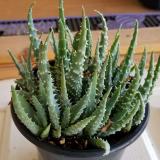文章
Dummer. ゛☀
2017年07月01日

The morphological characteristics of color.
Three bindweed is annual or perennial herbs. Stems climbing, ascending, leaves narrowly oblong to , apex obtuse, entire; neck short, sparsely flowered, solitary. Corolla bell shaped or funnel-shaped, blue, red, yellow and white edge, throat, annual, erect or climbing stems, branches and flowers in drooping, white star shaped block, and yellow flower, and the outer ring around a single color red, blue, pink or white flowers that look like, but if only. Open a day, it is true, a flower has three color color.
The growth habit of the three.
In 3 ~ May tricolor sowing, flowering from 6 to July, more open in the morning.
tricolor warm, humid, sunny; lax to requirement, can choose organic builder to cultivate soil for cultivation, soil fertility during the need to keep moist, not dry, and placed in outdoor light, after sowing after about 70 to 90 days will be open to a flower, to one and a half months before flowering, every two weeks a month applying fertilizer, increase the soil fertility and the flowering of bright colors;
A vine with three bindweed, so in the growth period when the stem elongation, can give moderate pruning, and support, to prevent lodging, also can be in pots or hanging flower beds, let it drop growth, is also a good choice.
Three the heat tolerance is good, but when in the summer comes, the hot weather is easy to make the plant significantly weakened, required to maintain the cultivation environment and ventilation; transpiration is fast, the need to pay attention to water supply, but the culture medium used for good drainage, so that the root rot easily in hot and humid conditions. And its cold resistance is also good, so the cultivation period can be extended to early autumn.
cultivation techniques
Most commonly with seeding breeding, sowing period is about in early spring to early summer can be suitable germination of about 18 to 25 DEG C, seeding in seedling tray, thin soil cover, keep the soil moist, in seedling tray coated on the transparent plastic cloth, to keep humidity, but not inside water, about 7 ~ 14 days to germination, then remove the plastic cloth, placed in bright light, the leaves of 3 ~ 5, can be transplanted to the basin, but not resistant seedlings three transplantation, the transplantation need careful attention, also can start live in the basin.



Three bindweed is annual or perennial herbs. Stems climbing, ascending, leaves narrowly oblong to , apex obtuse, entire; neck short, sparsely flowered, solitary. Corolla bell shaped or funnel-shaped, blue, red, yellow and white edge, throat, annual, erect or climbing stems, branches and flowers in drooping, white star shaped block, and yellow flower, and the outer ring around a single color red, blue, pink or white flowers that look like, but if only. Open a day, it is true, a flower has three color color.
The growth habit of the three.
In 3 ~ May tricolor sowing, flowering from 6 to July, more open in the morning.
tricolor warm, humid, sunny; lax to requirement, can choose organic builder to cultivate soil for cultivation, soil fertility during the need to keep moist, not dry, and placed in outdoor light, after sowing after about 70 to 90 days will be open to a flower, to one and a half months before flowering, every two weeks a month applying fertilizer, increase the soil fertility and the flowering of bright colors;
A vine with three bindweed, so in the growth period when the stem elongation, can give moderate pruning, and support, to prevent lodging, also can be in pots or hanging flower beds, let it drop growth, is also a good choice.
Three the heat tolerance is good, but when in the summer comes, the hot weather is easy to make the plant significantly weakened, required to maintain the cultivation environment and ventilation; transpiration is fast, the need to pay attention to water supply, but the culture medium used for good drainage, so that the root rot easily in hot and humid conditions. And its cold resistance is also good, so the cultivation period can be extended to early autumn.
cultivation techniques
Most commonly with seeding breeding, sowing period is about in early spring to early summer can be suitable germination of about 18 to 25 DEG C, seeding in seedling tray, thin soil cover, keep the soil moist, in seedling tray coated on the transparent plastic cloth, to keep humidity, but not inside water, about 7 ~ 14 days to germination, then remove the plastic cloth, placed in bright light, the leaves of 3 ~ 5, can be transplanted to the basin, but not resistant seedlings three transplantation, the transplantation need careful attention, also can start live in the basin.



1
0
文章
Abigal
2017年05月22日

Add a vertical touch in your container garden by growing climbing plants for containers. Must see these 24 best vines for pots.
The climbing plants in pots can bring a real touch of nature to any place, and they are a good way to add some privacy, too. These plants will create a nest of greenery where you can relax and rejuvenate and harbor in the mild soothing fragrance and lively colors.
1. Ivy

Ivy is one of the best climbers for containers. Its ability to adapt to all types of position makes it an excellent choice for beginners. It can grow up to 80 feet high, and its evergreen foliage remains green even in winters. Plant it in a container that is wide and shallow rather than narrow and deep.
2. Morning Glory

Morning glories are a good option and one of the best creepers or vines for containers. This old-fashioned plant is easy to grow.
3. Clematis

Clematis is the perfect plant to add vertical height and interest to any container garden. Plant clematis in a large container. Fertilize this plant regularly and make sure to always water it thoroughly and deeply.
4. Virginia Creeper

Virginia Creeper’s foliage turn into a beautiful red in the autumn. You can also grow it in a pot, even on a balcony. It improves privacy! To grow this, find a really big container and provide sturdy support of a trellis.
5. Climbing Hydrangea
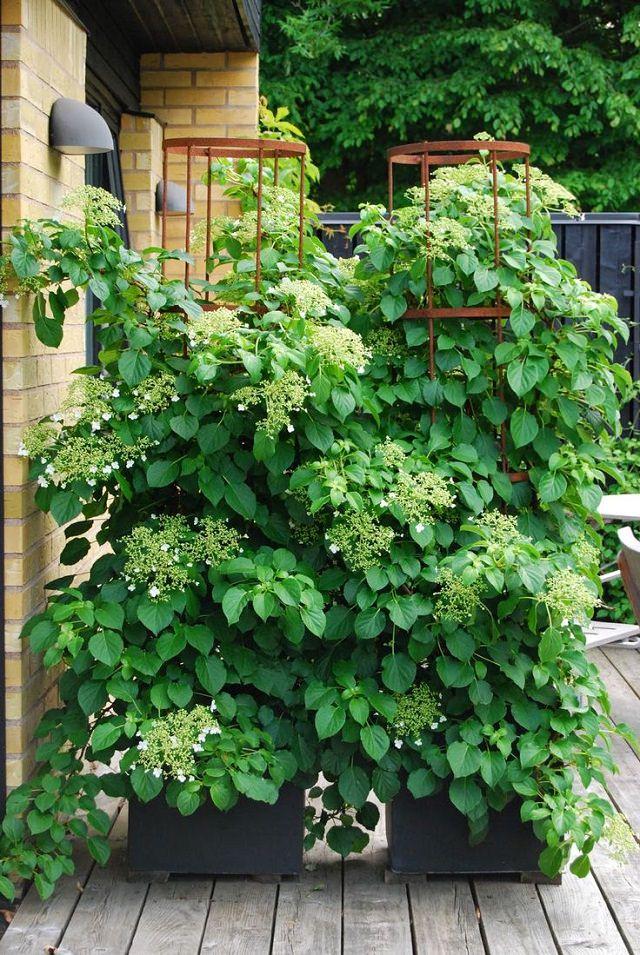
Climbing hydrangea is a great option, if you live under the USDA Zones 5-8 and have a lot of room as this vine can grow up to 70 feet long. It is shade tolerant and thrives best in semi-shaded positions. This plant needs a large pot of about of the size of the half of a whiskey barrel.
6. Trumpet vine

This big (up to 40 ft.) and a fast growing vine is considered as a weed in some parts due to its invasiveness. Despite the fact, this plant is famous for its trumpet-shaped flowers that come in shades of yellow to red and attract hummingbirds. Trumpet vine is more suitable for warm temperates, still it can acclimatize and grow in cooler regions if the protection from cold is provided in winter.
7. Bougainvillea

The bougainvillea is not a vine but a climbing shrub, it is easy to grow, colorful and controllable. You can grow it to give a tropical touch to your container garden. As bougainvillea is a tropical plant, the protection in winter is required in temperate zones.
8. Honeysuckle

There are about 180 different varieties of honeysuckle available as vines and creepers and can be grown diversely in a variety of climates (USDA Zones 3-11). Most of the honeysuckle varieties are evergreen in warmer climates. When growing honeysuckle, place the plant in full sun and do a regular watering. Occasional feeding with balanced fertilizer is enough.
9. Wisteria

Wisteria is one the most popular vines and it grows best in moderately cool climate. It can become huge, however, by providing solid support to the wisteria vine and some space you can grow it in a container, too. Also, it is required that you transplant this plant time to time into one size bigger pot. You can learn how to grow wisteria in a pot here.
10. Common Jasmine

Truly the most fragrant flower. Even its heady fragrance is sometimes too much for some people. The Jasminum Officinalis is easy to grow in containers and requires well-draining soil and warmth (hardy in USDA Zones 8-11) to thrive. The plant usually blooms in summer but in tropics, jasmines are evergreen and in flower most of the year.
11. Confederate Jasmine

Confederate jasmine is a robust plant. It has moderate watering needs and doesn’t mind the hot and humid weather. Similar to other jasmines, it also likes warm climate and exposure to the sun. The beautiful star-shaped flowers appear in clusters. This vine is suitable for containers as it only grows up to 20 ft. long.
12. Climbing Rose
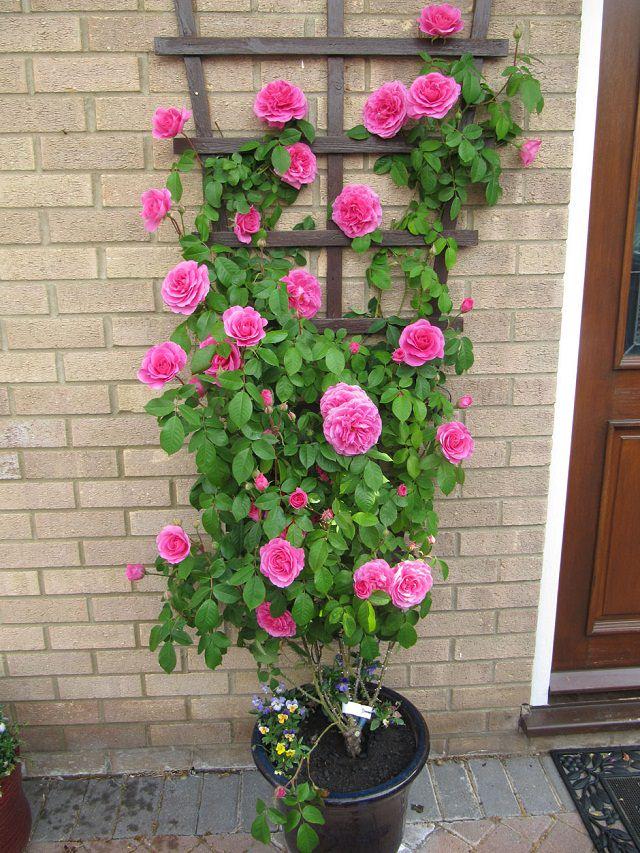
Climbing roses bloom prolifically, many varieties have a pleasant rosy scent. Consider the overall mature size of the variety that you are going to grow and the time you can devote to it, as roses require care and maintenance. Prune the plant on time and regularly remove the faded flowers to keep it in an attractive appearance.
Also Read: How to Make a Container Rose Garden
13. Mandevilla

Mandevilla is an eye catcher. With proper care and an optimal location to enjoy the graceful, funnel-shaped flowers of this plant appear all summer. However, Mandevilla requires warm climate to thrive but you can still grow it as an annual in cooler zones.
14. Cup and Saucer Vine

Cup and saucer vine is a fast growing abundant flowering plant that is native to Mexico. It blooms prolifically but to do this the plant needs an optimal bright location. In temperates, you can grow it either as an annual or protect the plant from winter by keeping it indoors.
15. Passion Flower

One of the most beautiful privacy protection plant for a container garden. If you prefer an exotic flair and extraordinary flowers, the passion flower is a right choice for you. It is important that you provide it sufficient sun. The passion flower is slightly frost resistant, but it should spend its time in a favorable spot in the winters.
16. Black-eyed Susan

Black-eyed Susan is a perennial vine that requires a sunny place and a trellis to climb on. This period flowering climbing plant can reach a height of over two meters with good care! Thus, the Black-eyed Susan is ideal if you want color and privacy in your container garden.
17. Dutchman’s Pipe
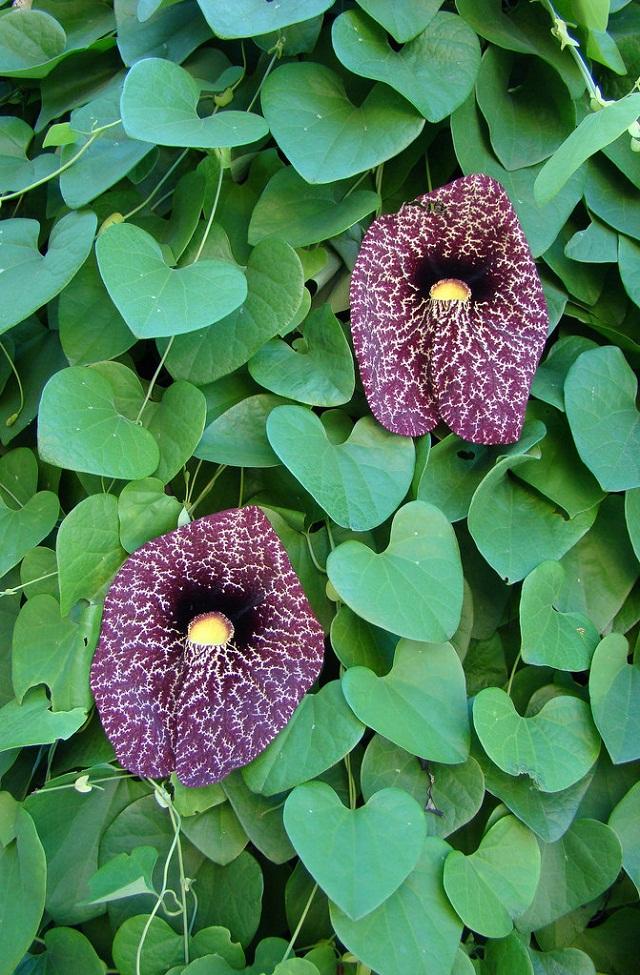
If you are looking for an unusual plant for your container garden, plant the dutchman’s pipe. The lush, large and heart-shaped foliage also provide interest apart from flowers that have a mildly unpleasant odor. Growing this unique plant as a perennial is only possible in warm subtropical or tropical climates. Everywhere else (as the plant is not frost tolerant) it must be grown in a greenhouse or indoors.
18. Butterfly Pea

Butterfly pea is a tropical vine and grows best in USDA Zones 10 and 11. In a cold temperate zone, grow this perennial as an annual. Plant it in a medium to a large sized container with a trellis to climb on from the initial stage.
19. Moonflower

Moonflower is a fantastic night blooming plant with large trumpet-shaped fragrant flowers. Place the pot near your patio or bedroom window to enjoy its fragrance in the night but make sure the place receives morning sun and light afternoon shade. Deadhead or remove the spent blooms to encourage more flowers.
20. Asarina Scandens
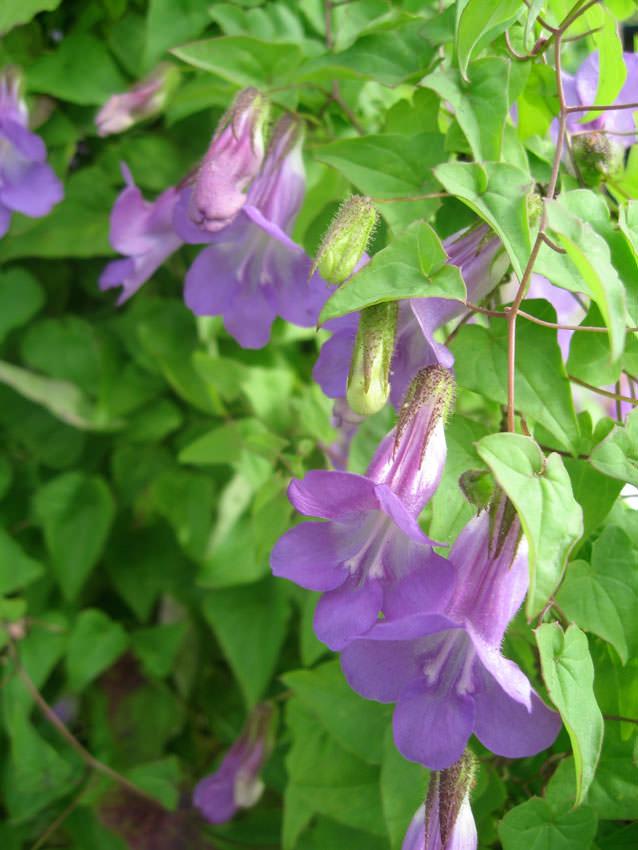
Asarina, which is also known as climbing snapdragon is perfect for growing in containers as it seldom exceeds the height of 8-10 feet. Many hybrid cultivars are available in the shade of different colors. You can also use this vine in hanging baskets or as a groundcover. Asarina is more a warm climate plant and often grown as an annual in temperates.
21. Canary Creeper
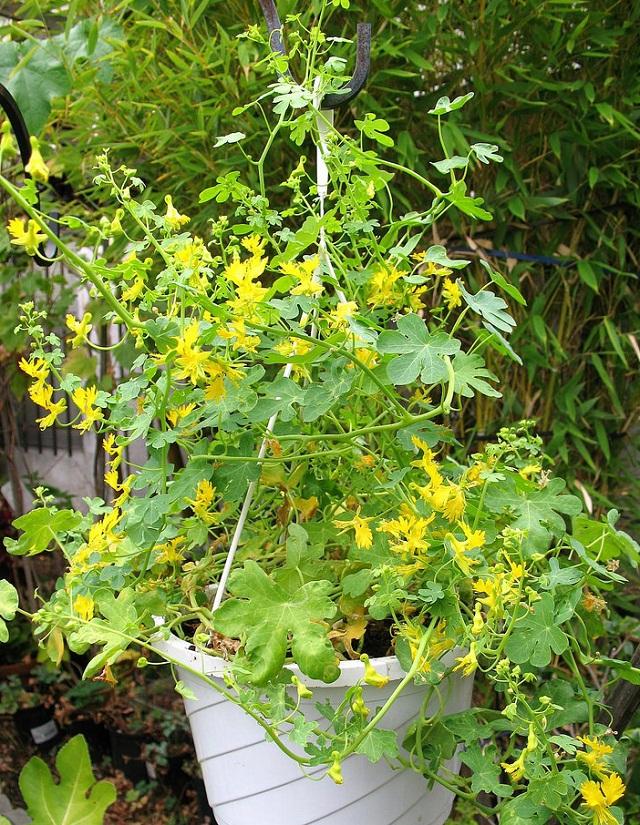
Let this annual vine ramble up on a trellis, and it will award you with its showy yellow flowers that look unmatchable. The canary creeper has long blooming period from summer to fall and even more in warm subtropical regions where it is perennial (USDA Zone 9 and higher).
22. Sweet Pea
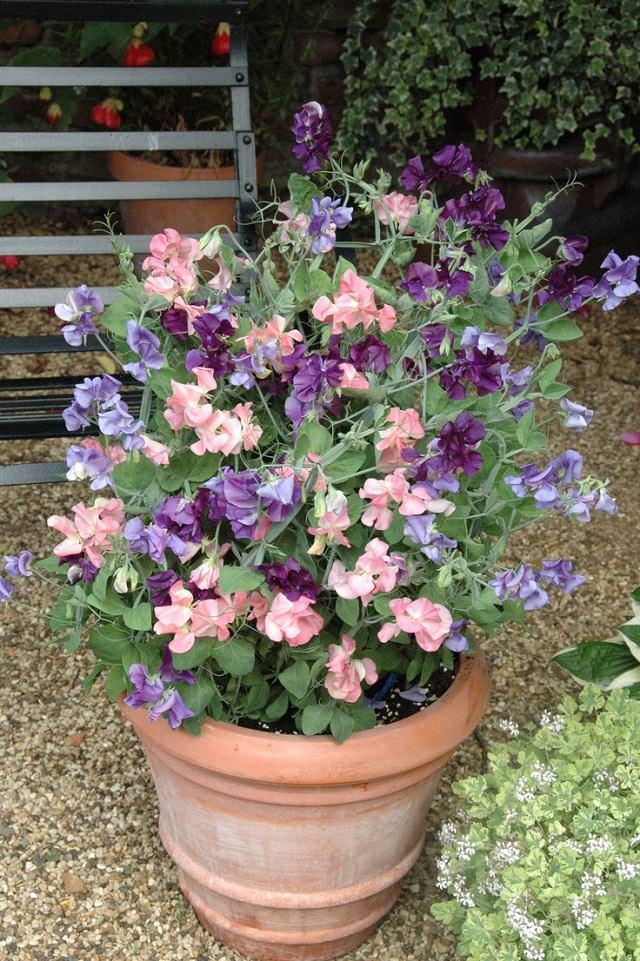
Grow sweet peas in warm zones in fall and winter. In temperates, plant this fragrant vine in spring or summer. When growing in containers choose bush type varieties.
23. Sweet Autumn Clematis

Sweet autumn clematis vine forms masses of amazingly fragrant flowers from late summer to fall (autumn). You can grow this vine diversely in both the cold and warm climates (USDA Zones 4-9). Also, in subtropical and tropical climates if shade from afternoon sun is provided.
24. Snail Vine

This beautiful tropical vine has rare snail-like fragrant flowers that are white in the beginning and later unfurl to lavender pink. However, it’s easy to grow snail vine in non-tropical zones, but the plant dies in winter and returns again in the spring.
The climbing plants in pots can bring a real touch of nature to any place, and they are a good way to add some privacy, too. These plants will create a nest of greenery where you can relax and rejuvenate and harbor in the mild soothing fragrance and lively colors.
1. Ivy

Ivy is one of the best climbers for containers. Its ability to adapt to all types of position makes it an excellent choice for beginners. It can grow up to 80 feet high, and its evergreen foliage remains green even in winters. Plant it in a container that is wide and shallow rather than narrow and deep.
2. Morning Glory

Morning glories are a good option and one of the best creepers or vines for containers. This old-fashioned plant is easy to grow.
3. Clematis

Clematis is the perfect plant to add vertical height and interest to any container garden. Plant clematis in a large container. Fertilize this plant regularly and make sure to always water it thoroughly and deeply.
4. Virginia Creeper

Virginia Creeper’s foliage turn into a beautiful red in the autumn. You can also grow it in a pot, even on a balcony. It improves privacy! To grow this, find a really big container and provide sturdy support of a trellis.
5. Climbing Hydrangea

Climbing hydrangea is a great option, if you live under the USDA Zones 5-8 and have a lot of room as this vine can grow up to 70 feet long. It is shade tolerant and thrives best in semi-shaded positions. This plant needs a large pot of about of the size of the half of a whiskey barrel.
6. Trumpet vine

This big (up to 40 ft.) and a fast growing vine is considered as a weed in some parts due to its invasiveness. Despite the fact, this plant is famous for its trumpet-shaped flowers that come in shades of yellow to red and attract hummingbirds. Trumpet vine is more suitable for warm temperates, still it can acclimatize and grow in cooler regions if the protection from cold is provided in winter.
7. Bougainvillea

The bougainvillea is not a vine but a climbing shrub, it is easy to grow, colorful and controllable. You can grow it to give a tropical touch to your container garden. As bougainvillea is a tropical plant, the protection in winter is required in temperate zones.
8. Honeysuckle

There are about 180 different varieties of honeysuckle available as vines and creepers and can be grown diversely in a variety of climates (USDA Zones 3-11). Most of the honeysuckle varieties are evergreen in warmer climates. When growing honeysuckle, place the plant in full sun and do a regular watering. Occasional feeding with balanced fertilizer is enough.
9. Wisteria

Wisteria is one the most popular vines and it grows best in moderately cool climate. It can become huge, however, by providing solid support to the wisteria vine and some space you can grow it in a container, too. Also, it is required that you transplant this plant time to time into one size bigger pot. You can learn how to grow wisteria in a pot here.
10. Common Jasmine

Truly the most fragrant flower. Even its heady fragrance is sometimes too much for some people. The Jasminum Officinalis is easy to grow in containers and requires well-draining soil and warmth (hardy in USDA Zones 8-11) to thrive. The plant usually blooms in summer but in tropics, jasmines are evergreen and in flower most of the year.
11. Confederate Jasmine

Confederate jasmine is a robust plant. It has moderate watering needs and doesn’t mind the hot and humid weather. Similar to other jasmines, it also likes warm climate and exposure to the sun. The beautiful star-shaped flowers appear in clusters. This vine is suitable for containers as it only grows up to 20 ft. long.
12. Climbing Rose

Climbing roses bloom prolifically, many varieties have a pleasant rosy scent. Consider the overall mature size of the variety that you are going to grow and the time you can devote to it, as roses require care and maintenance. Prune the plant on time and regularly remove the faded flowers to keep it in an attractive appearance.
Also Read: How to Make a Container Rose Garden
13. Mandevilla

Mandevilla is an eye catcher. With proper care and an optimal location to enjoy the graceful, funnel-shaped flowers of this plant appear all summer. However, Mandevilla requires warm climate to thrive but you can still grow it as an annual in cooler zones.
14. Cup and Saucer Vine

Cup and saucer vine is a fast growing abundant flowering plant that is native to Mexico. It blooms prolifically but to do this the plant needs an optimal bright location. In temperates, you can grow it either as an annual or protect the plant from winter by keeping it indoors.
15. Passion Flower

One of the most beautiful privacy protection plant for a container garden. If you prefer an exotic flair and extraordinary flowers, the passion flower is a right choice for you. It is important that you provide it sufficient sun. The passion flower is slightly frost resistant, but it should spend its time in a favorable spot in the winters.
16. Black-eyed Susan

Black-eyed Susan is a perennial vine that requires a sunny place and a trellis to climb on. This period flowering climbing plant can reach a height of over two meters with good care! Thus, the Black-eyed Susan is ideal if you want color and privacy in your container garden.
17. Dutchman’s Pipe

If you are looking for an unusual plant for your container garden, plant the dutchman’s pipe. The lush, large and heart-shaped foliage also provide interest apart from flowers that have a mildly unpleasant odor. Growing this unique plant as a perennial is only possible in warm subtropical or tropical climates. Everywhere else (as the plant is not frost tolerant) it must be grown in a greenhouse or indoors.
18. Butterfly Pea

Butterfly pea is a tropical vine and grows best in USDA Zones 10 and 11. In a cold temperate zone, grow this perennial as an annual. Plant it in a medium to a large sized container with a trellis to climb on from the initial stage.
19. Moonflower

Moonflower is a fantastic night blooming plant with large trumpet-shaped fragrant flowers. Place the pot near your patio or bedroom window to enjoy its fragrance in the night but make sure the place receives morning sun and light afternoon shade. Deadhead or remove the spent blooms to encourage more flowers.
20. Asarina Scandens

Asarina, which is also known as climbing snapdragon is perfect for growing in containers as it seldom exceeds the height of 8-10 feet. Many hybrid cultivars are available in the shade of different colors. You can also use this vine in hanging baskets or as a groundcover. Asarina is more a warm climate plant and often grown as an annual in temperates.
21. Canary Creeper

Let this annual vine ramble up on a trellis, and it will award you with its showy yellow flowers that look unmatchable. The canary creeper has long blooming period from summer to fall and even more in warm subtropical regions where it is perennial (USDA Zone 9 and higher).
22. Sweet Pea

Grow sweet peas in warm zones in fall and winter. In temperates, plant this fragrant vine in spring or summer. When growing in containers choose bush type varieties.
23. Sweet Autumn Clematis

Sweet autumn clematis vine forms masses of amazingly fragrant flowers from late summer to fall (autumn). You can grow this vine diversely in both the cold and warm climates (USDA Zones 4-9). Also, in subtropical and tropical climates if shade from afternoon sun is provided.
24. Snail Vine

This beautiful tropical vine has rare snail-like fragrant flowers that are white in the beginning and later unfurl to lavender pink. However, it’s easy to grow snail vine in non-tropical zones, but the plant dies in winter and returns again in the spring.
1
0
文章
Abigal
2017年05月22日

Checkout 19 best pergola plants for your garden. These climbing plants for pergolas and arbors can also be grown in small gardens easily.

There are so many climbing plants that can be guided over a pergola to get a welcome shade in warm weather. For your help, here we have listed 19 best pergola plants. This list is a combination of both tropical and temperate vines.
Best Pergola PlantsRose

Roses are classic. They are the favorite plants of most gardeners as they produce a feeling of being special, tranquility, nostalgia, romance, and happiness. Climbing varieties are perfect to cover a pergola and arches.
Clematis

Surely, one of the best pergola plants. Clematis is a spectacular vine as it blooms abundantly, flowering usually starts from spring. You can grow it easily and combine with other plants, especially with climbing roses to get a more exquisite view.
Honeysuckle

The fragrance of honeysuckle flowers is nostalgic and multiplies when dusk sets. It has more than 180 different species, almost all are creepers. It is a very large vine that grows rapidly, a single honeysuckle plant can cover up a big sturdy pergola easily.
Passion Flower (Passiflora)

Passion flower is a beautiful fast growing, hardy perennial in tropics. The heady fragrance, colorful flowers, and edible fruits make it one of most desirable climbing plant you can have in your garden. You can also grow it on your balcony, rooftop or patio garden. Growing passion flower is easy if you live in the subtropical or tropical climate (USDA Zone 8 – 11). If you live in the temperate region then look for its cold hardy cultivars. In very cool climate you can grow it as annual.
Jasmine
 "1000084172_1000000025_1487218527.jpg">Surely, jasmine is the most intense flower. Its fragrance can be smelt from far-far away. So if you love fragrant plants, grow it. In warm and humid climates jasmine blooms year round. In cooler zones, grow it as annual.
"1000084172_1000000025_1487218527.jpg">Surely, jasmine is the most intense flower. Its fragrance can be smelt from far-far away. So if you love fragrant plants, grow it. In warm and humid climates jasmine blooms year round. In cooler zones, grow it as annual.
Grape Vine

Truly one of the best climbing plants for pergolas, grape vine will not only give shade and a warm sitting place but juicy grapefruits too. You can grow this in a variety of climates. Grapevine varieties are native to Mediterranean, Central Asia, America and South West Asia, thus cultivars available diversely. Here’s an interesting article on training grapevine on arbor, which you can read.
Wisteria

Lavender blue color of wisteria flowers and the sweet fragrance is fascinating. However, wisteria is an aggressive grower but it takes the time to establish. You can grow wisteria in temperate and subtropical regions (USDA Zones 4 – 9). If you have a large sturdy pergola grow wisteria on it, you’ll need to prune regularly to control its growth.
Trumpet Vine (Campsis radicans)

Due to its showy trumpet-shaped flowers, it is called trumpet vine. Each of trumpet vine flowers can appear in different colors (orange, yellow or red). The flowers attract pollinators: bees, and hummingbirds. This plant looks great on the arches, pergolas, and trellises. It grows best in full sun to part sun.
Bignonia (Cross Vine)

Another beautiful climber, related to trumpet vine. Its delicate bell-shaped flowers look great on pergolas. It is a fairly vigorous plant and tolerates mild to moderate frost, grows best in USDA Zones (6 – 9). You can also try growing it in tropics (Zone 10) in shade from afternoon sun.
Ivy

For the arbors, pergolas, and gazebos situated in shade, ivy is best. It is low maintenance and tolerates the exploits of weather and provides lush green color. You can also choose variegated varieties.
Bougainvillea

The climbing varieties of bougainvillea are suitable for the pergolas. This plant loves the sunny position and does not like wet feet. Among the most frequently cultivated colors are pink, red, yellow and purple but it comes in many other colors too.
Morning glory

A vine that greets the morning sun with its pretty blooms. Morning glory vine is fairly easy to grow and it perks up quickly. A good plant to cover up a pergola that is in a sunny position.
Kiwi

A kiwi vine takes a lot of space to grow that is why it is one of the best pergola plants in our list. In order to get fruits from the kiwi plant, you’ll need to have both male and female plants for pollination.
Sweet pea

Don’t grow bush type varieties if you are growing it over the pergola. Plant sweet peas in the sun and in a well-drained soil. Grow sweet peas in warm zones in fall and winter. In temperates plant this fragrant vine in spring or summer.
Bleeding heart

If you’re searching for a climber for shade, bleeding heart is one. Its beautiful heart shaped flowers looks exotic. This plant requires moist soil and a location that receives partial sun. Bleeding heart is suitable for cold temperate climates and can be grown in USDA Zones 3 – 9.
Tropical Bleeding Heart (Glory Bower)

Exquisite flowers and dark glossy foliage. The tropical bleeding heart vine is native to Western Africa, its flowers resemble the bleeding heart (Dicentra spectabilis), see above. Both have different requirements and tropical bleeding heart thrives well in heat and warmth (USDA Zones 10 – 11). *You can also grow it as a houseplant.
Butterfly Pea

Butterfly pea flowers are the best food source for butterflies. It is a legume and both flowers and seed pods are edible. The most attractive thing about butterfly pea vine is its shiny deep blue flowers. Butterfly pea is a tropical vine and grows best in USDA Zones 10 and 11. In a cold temperate zone, grow this perennial as annual.
Golden Hops

A fast growing vine that quickly covers up the trellises, pergolas, and arches. Golden hops can grow up to 8 m long without any difficulty. What makes it beautiful is its lime green or yellowish foliage. It is a low maintenance cold hardy vine (USDA Zones 4 – 8), not suitable for warm climates.
Climbing Hydrangea

Growing climbing hydrangea vine is rewarding due to its glossy heart-shaped foliage and fragrant white flowers that appear in clusters in spring to summer. It is a slow grower and requires training and pruning. You can grow climbing hydrangea if you live in the colder region within USDA Zones 5 – 8.

There are so many climbing plants that can be guided over a pergola to get a welcome shade in warm weather. For your help, here we have listed 19 best pergola plants. This list is a combination of both tropical and temperate vines.
Best Pergola PlantsRose

Roses are classic. They are the favorite plants of most gardeners as they produce a feeling of being special, tranquility, nostalgia, romance, and happiness. Climbing varieties are perfect to cover a pergola and arches.
Clematis

Surely, one of the best pergola plants. Clematis is a spectacular vine as it blooms abundantly, flowering usually starts from spring. You can grow it easily and combine with other plants, especially with climbing roses to get a more exquisite view.
Honeysuckle

The fragrance of honeysuckle flowers is nostalgic and multiplies when dusk sets. It has more than 180 different species, almost all are creepers. It is a very large vine that grows rapidly, a single honeysuckle plant can cover up a big sturdy pergola easily.
Passion Flower (Passiflora)

Passion flower is a beautiful fast growing, hardy perennial in tropics. The heady fragrance, colorful flowers, and edible fruits make it one of most desirable climbing plant you can have in your garden. You can also grow it on your balcony, rooftop or patio garden. Growing passion flower is easy if you live in the subtropical or tropical climate (USDA Zone 8 – 11). If you live in the temperate region then look for its cold hardy cultivars. In very cool climate you can grow it as annual.
Jasmine
Grape Vine

Truly one of the best climbing plants for pergolas, grape vine will not only give shade and a warm sitting place but juicy grapefruits too. You can grow this in a variety of climates. Grapevine varieties are native to Mediterranean, Central Asia, America and South West Asia, thus cultivars available diversely. Here’s an interesting article on training grapevine on arbor, which you can read.
Wisteria

Lavender blue color of wisteria flowers and the sweet fragrance is fascinating. However, wisteria is an aggressive grower but it takes the time to establish. You can grow wisteria in temperate and subtropical regions (USDA Zones 4 – 9). If you have a large sturdy pergola grow wisteria on it, you’ll need to prune regularly to control its growth.
Trumpet Vine (Campsis radicans)

Due to its showy trumpet-shaped flowers, it is called trumpet vine. Each of trumpet vine flowers can appear in different colors (orange, yellow or red). The flowers attract pollinators: bees, and hummingbirds. This plant looks great on the arches, pergolas, and trellises. It grows best in full sun to part sun.
Bignonia (Cross Vine)

Another beautiful climber, related to trumpet vine. Its delicate bell-shaped flowers look great on pergolas. It is a fairly vigorous plant and tolerates mild to moderate frost, grows best in USDA Zones (6 – 9). You can also try growing it in tropics (Zone 10) in shade from afternoon sun.
Ivy

For the arbors, pergolas, and gazebos situated in shade, ivy is best. It is low maintenance and tolerates the exploits of weather and provides lush green color. You can also choose variegated varieties.
Bougainvillea

The climbing varieties of bougainvillea are suitable for the pergolas. This plant loves the sunny position and does not like wet feet. Among the most frequently cultivated colors are pink, red, yellow and purple but it comes in many other colors too.
Morning glory

A vine that greets the morning sun with its pretty blooms. Morning glory vine is fairly easy to grow and it perks up quickly. A good plant to cover up a pergola that is in a sunny position.
Kiwi

A kiwi vine takes a lot of space to grow that is why it is one of the best pergola plants in our list. In order to get fruits from the kiwi plant, you’ll need to have both male and female plants for pollination.
Sweet pea

Don’t grow bush type varieties if you are growing it over the pergola. Plant sweet peas in the sun and in a well-drained soil. Grow sweet peas in warm zones in fall and winter. In temperates plant this fragrant vine in spring or summer.
Bleeding heart

If you’re searching for a climber for shade, bleeding heart is one. Its beautiful heart shaped flowers looks exotic. This plant requires moist soil and a location that receives partial sun. Bleeding heart is suitable for cold temperate climates and can be grown in USDA Zones 3 – 9.
Tropical Bleeding Heart (Glory Bower)

Exquisite flowers and dark glossy foliage. The tropical bleeding heart vine is native to Western Africa, its flowers resemble the bleeding heart (Dicentra spectabilis), see above. Both have different requirements and tropical bleeding heart thrives well in heat and warmth (USDA Zones 10 – 11). *You can also grow it as a houseplant.
Butterfly Pea

Butterfly pea flowers are the best food source for butterflies. It is a legume and both flowers and seed pods are edible. The most attractive thing about butterfly pea vine is its shiny deep blue flowers. Butterfly pea is a tropical vine and grows best in USDA Zones 10 and 11. In a cold temperate zone, grow this perennial as annual.
Golden Hops

A fast growing vine that quickly covers up the trellises, pergolas, and arches. Golden hops can grow up to 8 m long without any difficulty. What makes it beautiful is its lime green or yellowish foliage. It is a low maintenance cold hardy vine (USDA Zones 4 – 8), not suitable for warm climates.
Climbing Hydrangea

Growing climbing hydrangea vine is rewarding due to its glossy heart-shaped foliage and fragrant white flowers that appear in clusters in spring to summer. It is a slow grower and requires training and pruning. You can grow climbing hydrangea if you live in the colder region within USDA Zones 5 – 8.
0
0






